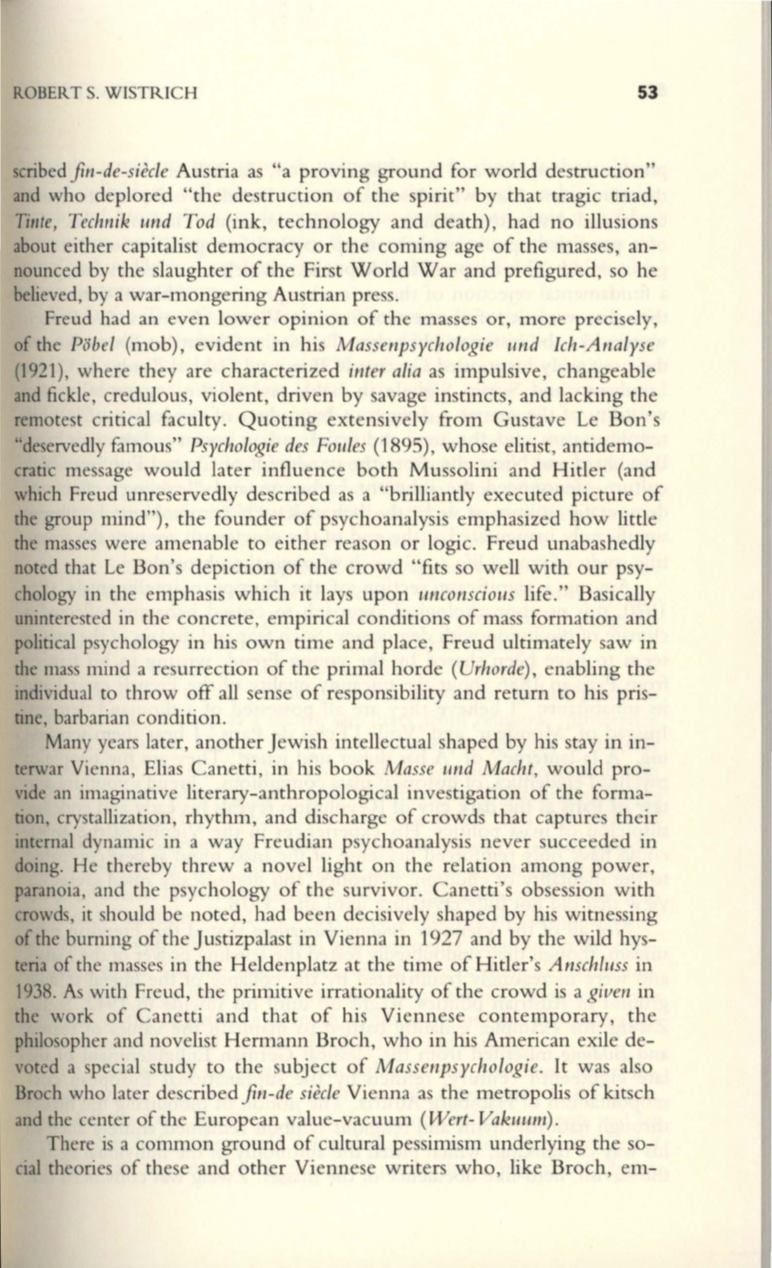
ROBERT
S. WISTRICH
53
scribed
fiI1-de-siecle
Austria as "a proving ground for world destruction"
and who deplored "the destruction of the spirit" by that tragic triad,
Tillte, Techl1ik und Tod
(ink, technology and death), had no illusions
about either capitalist democracy or the coming age of the masses, an–
nounced by the slaughter of the First World War and prefigured, so he
believed, by a war-mongering Austrian press.
Freud had an even lower opinion of the masses or, more precisely,
of the
Pobel
(mob), evident in his
Massenpsychologie und Ich-Analyse
(1921), where they are characterized
inter alia
as impulsive, changeable
and fickle, credulous, violent, driven by savage instincts, and lacking the
remotest critical faculty. Quoting extensively from Gustave Le Bon's
"deservedly famous"
Psychologie des Foules
(1895), whose elitist, antidemo–
cratic message would later influence both Mussolini and Hitler (and
which Freud unreservedly described as a "brilliantly executed picture of
the group mind"), the founder of psychoanalysis emphasized how little
the masses were amenable to either reason or logic. Freud unabashedly
noted that Le Bon' depiction of the crowd "fits so well with our psy–
chology in the emphasis which it lays upon
unconscious
life." Basically
uninterested in the concrete, empirical conditions of mass formation and
political psychology in his own time and place, Freud ultimately saw in
the mass mind a resurrection of the primal horde
(Urhorde),
enabling the
individual to throw off all sense of responsibility and return to his pris–
tine, barbarian condition.
Many years later, another Jewish intellectual shaped by his stay in in–
terwar Vienna, Elias Canetti, in his book
Masse IIlld Macht,
would pro–
vide an imaginative literary-anthropological investigation of the forma–
tion, crystallization, rhythm, and discharge of crowds that captures their
internal dynamic in a way Freudian psychoanalysis never succeeded in
doing. He thereby threw a novel light on the relation among power,
paranoia, and the psychology of the survivor. Canetti's obsession with
crowds, it should be noted, had been decisively shaped by his witnessing
of the burning of the Justizpalast in Vienna in 1927 and by the wild hys–
teria of the masses in the Heldenplatz at the time of Hitler's
Anschlllss
in
1938. As with Freud, the primitive irrationality of the crowd is a
given
in
the work of Canetti and that of his Viennese contemporary, the
philosopher and novelist Hermann Broch, who in his American exile de–
voted a special study to the subject of
Massel1psychologie.
It
was also
Broch who later described
fin-de siecle
Vienna as the metropolis of kitsch
and the center of the European value-vacuum
(Wert- Vakllum).
There is a common ground of cultural pessimism underlying the so–
cial theories of the e and other Viennese writers who, like Broch, em-


